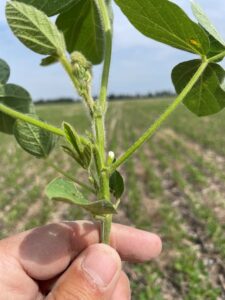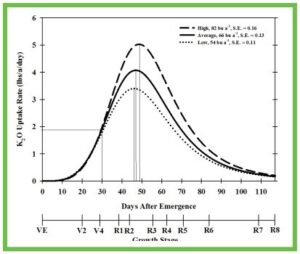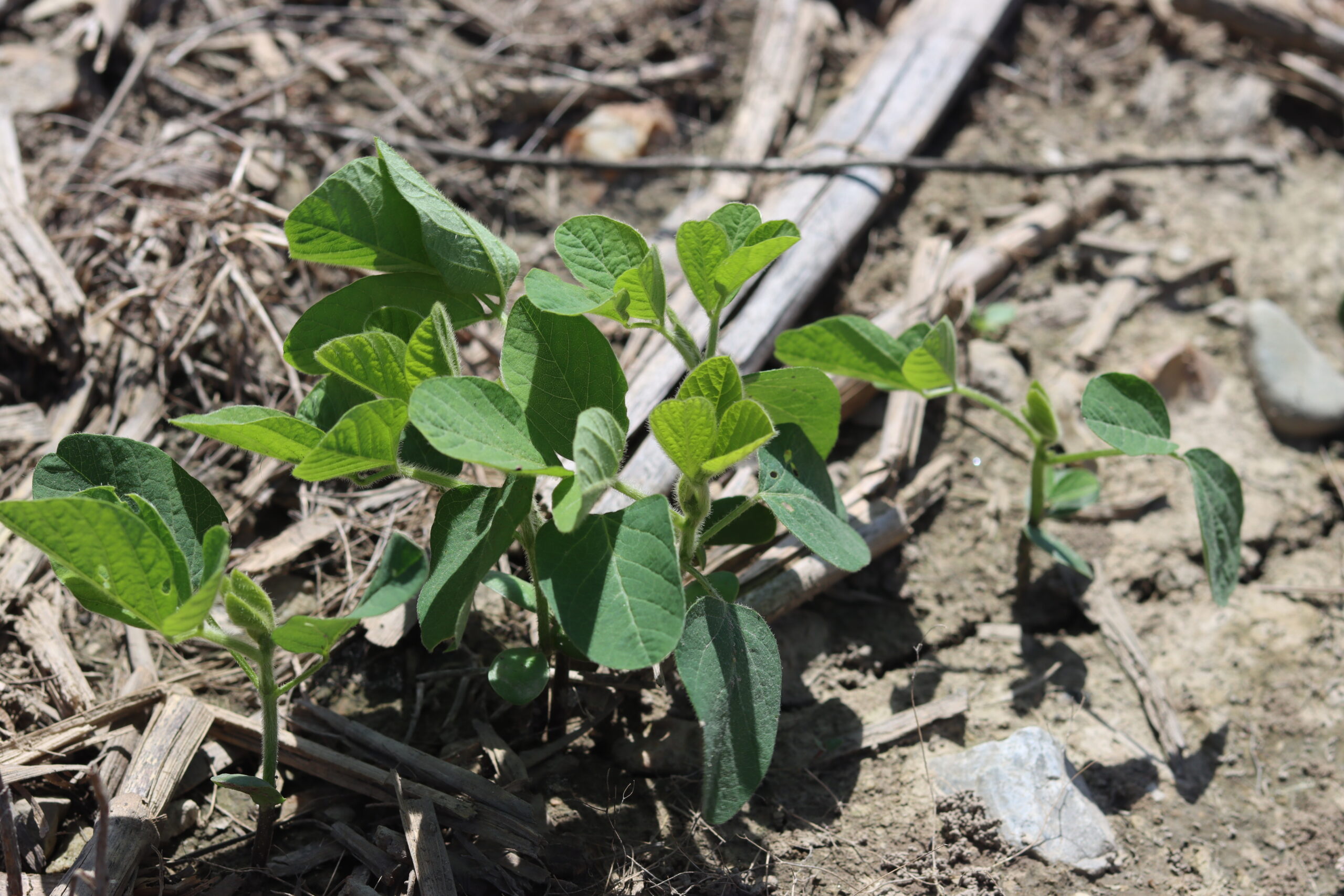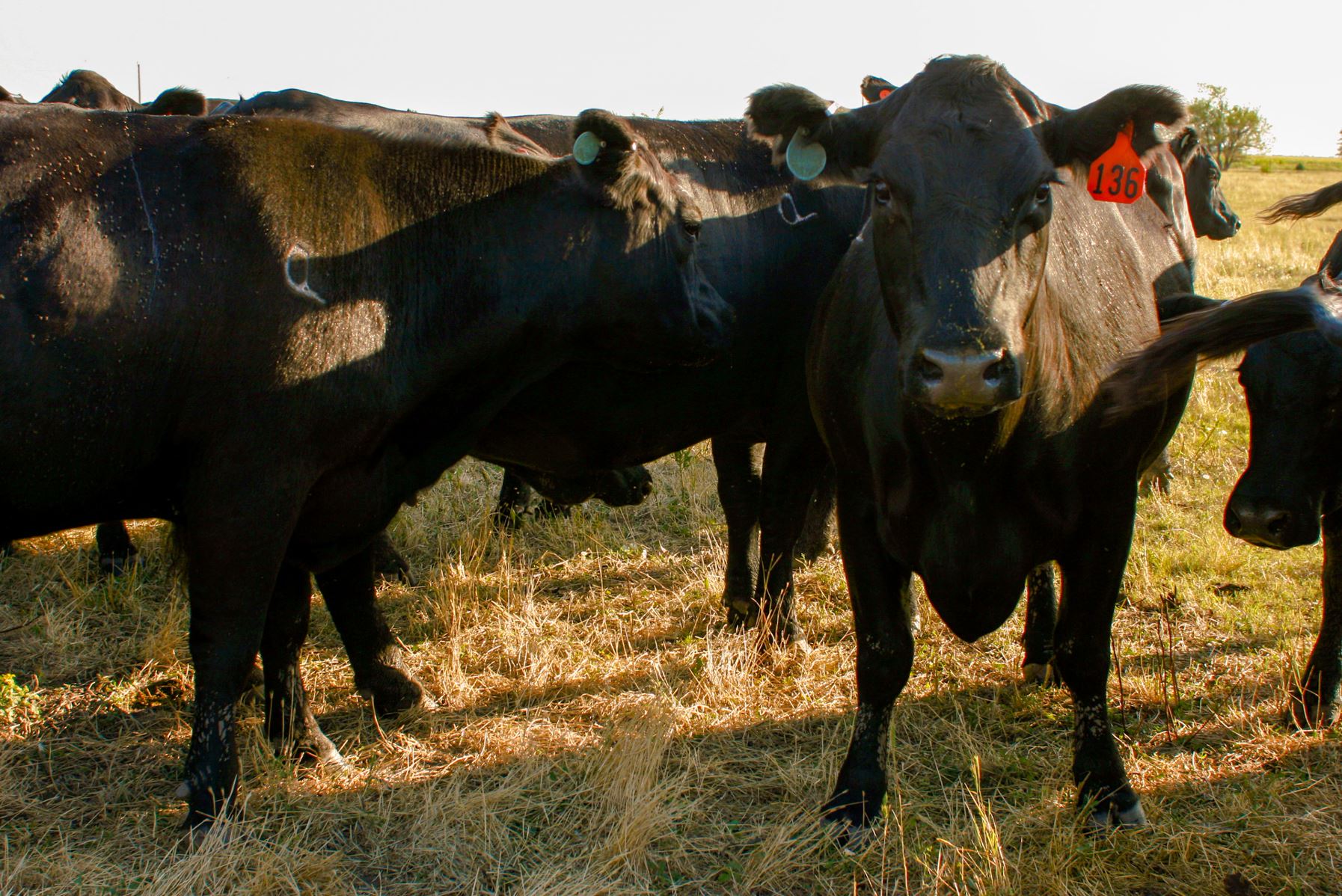Other than the dry weather slowing things down for some folks, this is generally a time of year filled with top-dress or side-dress applications of nitrogen on corn.

We have learned over the years that corn generally responds to intensified in-season management. However, other than herbicide and fungicide/insecticide applications, we generally don’t give much thought to in-season management in soybeans. Why is that? High yield soybean producers focus intensively on in-season management. As early planted soybeans are starting to send out flowers in Central Missouri, I wanted to provide a few thoughts that support in-season nutrient management in soybeans.
Season Long Nutrient Demand
Some recent tissue sampling work from Pioneer showed that high yielding soybeans (86-123 bu/acre) have a critical need for many nutrients season-long. They noted that in these high yielding soybeans, sufficiency ranges for many of the nutrients (many macro and micronutrients) were higher than what the current published nutrient sufficiency ranges would state. That is a long-winded way of saying if you sent a tissue sample to the lab and you were pushing for 100 bushel per acre soybeans, what the lab might state as a sufficient amount of a certain nutrient, the Pioneer data might indicate as below what is needed for that yield range. Also, this recent data illustrated that nutrient sufficiency ranges in the later reproductive stages should be higher for many nutrients than what is currently published as sufficient.
You can read the entire article here. In essence, this work is continuing to support the fact that soybeans have a season long demand of many nutrients.
Massive Uptake of Nutrients in the Reproductive Stages
The University of Wisconsin did some work in 2014 and 2015 to measure uptake of various nutrients over time in high (82 bu/acre), average (66 bu/acre), and low (54 bu/acre) yielding soybeans. Their work outlines the enormous season long demand of various nutrients by soybeans. We know soybeans remove a large amount of potassium. An 80 bu/acre soybean crop removes 94 lbs./acre of potash, but uptakes a total of 184 lbs./acre of potash (removal is carried off the field in the grain, but uptake tells you how much the crop took in throughout its life cycle with some returned to the field in the residue). That total uptake and removal is massive. However, when you look at the demand over time, it is mind-boggling. In their work, high yielding soybeans reached peak demand of 5.2 lbs. of potash per acre per day just after the R2 stage. That is an astronomical amount!
Other nutrients like phosphorus had a peak uptake rate of 1.2 lbs. of phosphate per acre per day between R3-R4 in high yielding soybeans. Sulfur had a peak uptake rate of 0.3 lbs. per acre per day at R3 on high yielding soybeans. I am not going to get into the supplemental nitrogen conversation on soybeans, but their work showed that high yielding soybeans hit a peak uptake rate of 4 lbs. of nitrogen per acre per day between R4-R5. Keep in mind that we are hitting peak nitrogen demand when nitrogen fixation within the plant is starting to decline.
Here is the entire article outlining the nutrient uptake work by the University of Wisconsin.
All this nutrient uptake data begs the question, can your soil hold enough nutrients preplant to fulfill the season long needs of high yielding soybeans? I suppose that also depends on how you define high yielding soybeans.
Impacts of Early Planting on Nutrient Demand
We all know the benefits of earlier planting when it comes to increasing yield potential. Have we ever thought about the impacts of earlier planting and increasing yield potential on nutrient demand? It is intuitive that as we increase yield potential that we increase nutrient removal and uptake by the soybean plant. However, this becomes a compounding effect in my mind with earlier planting. Because now we are not only increasing nutrient removal and uptake by raising a higher yielding crop, but we are also increasing the length of the nutrient demand over time. In my last article earlier this spring, I talked about the importance of early season fertility (i.e., nutrients like sulfur) with early planted soybeans. However, we also must think about the other side of that nutrient uptake later out into the season. Can we fulfill all that soybean crop’s needs from a preplant fertilizer application alone?
Reproductive Nutrient Demand of Micronutrients
Soybean uptake of micronutrients is minimal compared to macronutrients like phosphorus, potassium, sulfur, etc. However, there is plant demand for micronutrients. Soil type, organic matter level, micronutrient levels in the soil, yield level, etc. can help you determine whether you have enough to meet demand in the soil. Many high yielding soybean producers have been experimenting with micronutrient applications for years. After you correct soil pH and macronutrient levels, then micronutrients could be the next place to look at. The root system is the most efficient way for the plant to take in most nutrients. However, due to very small application rates of dry micronutrient fertilizer per acre (i.e., spreading one lb. of dry product per acre and expecting precision application of that) coupled with some micronutrients needed in very small amounts, some folks may elect to apply certain micronutrients as a foliar fertilizer (i.e., “foliar feed”). My goal here is not to tell you whether you should use a foliar fertilizer, but if you choose to, I want you to think a little bit about the timing. Peak demand of many of the micronutrients by soybeans hits at R3 (beginning pod). Many times, the foliar fertilizer is combined with the fungicide + insecticide application, which also happens at R3. That seems to make a lot of sense on paper. However, it takes some time for that nutrient to get into the plant and ready for use. You want the nutrients in the plant ready to go before peak demand. My point here is if you are doing one foliar fertilizer pass, consider moving it up. Let’s try feeding the plant at R1 (beginning flowering) versus R3. At R1 the plant is on a steep incline towards peak demand at R3. Also, an application at R1 gives time to get the nutrient into the plant before it hits peak demand at R3. An application at R3 is not a waste, it is just feeding the plant as its demand is going down versus up.
In season nutrient applications add a layer of complexity to every operation. They may not fit the needs or goals of everyone. However, as we push soybean yields higher and higher, I think they offer an avenue to continue to push the yield ceiling. Could in-season applications allow us to gain certain nutrient efficiency like we do with side-dressing nitrogen in corn? Could more intense in-season management open another door for the ever changing world of biological products?
My last word of caution, if you decide to experiment with in-season nutrient applications on your soybeans, everyone has an opinion on when the best time is to apply them. However, my advice is to factor in a little extra time for Missouri dryland acres to get that rain and push it into the plant before it hits peak demand.


